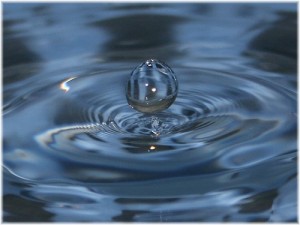The next time you turn on the faucet or take a shower, take time to realize that you live in a desert where the average rainfall in the Phoenix valley is less than 9 inches/year but the average person uses 150 gallons of water PER day. So how do we satisfy our “thirst” for water that exceeds our natural supply in the valley?
**
Water sources that we depend upon
City and towns in Phoenix depend upon a combination of water sources or supplies. Each city depends on these sources in varying degrees.
- SRP water that comes from the Salt and Verde River watersheds.
- Colorado River water that is delivered via the Central Arizona Project (CAP) canal.
- Ground water that is pumped from aquifers below the surface.
- Reclaimed water that is treated and used for non-potable uses.
SRP water from the Salt and Verde watersheds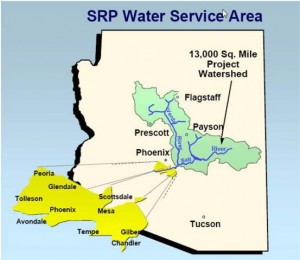
SRP delivers water from the Salt and Verde rivers to cities that have water rights that are “appurtenant” or connected to the land. The cities that have water rights to water from the Salt and Verde watersheds that is delivered via the SRP are Avondale, Chandler, Gilbert, Glendale, Mesa, Peoria, Phoenix, Scottsdale, Tempe and Tolleson. Each city receives water based on the land included in the SRP service area for which they have water rights. The service area does not necessarily align with city boundaries. Gilbert for example, has 12,585 acres of land with no SRP water rights. The total SRP service area consists of 248,000 acres and draws from the Salt and Verde river watersheds that cover 13,000 square miles, or approximately 11% of the state of Arizona (114,000 sq.miles).
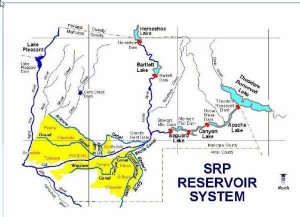 SRP water is stored in 6 reserviors; 4 on the Salt River and 2 on the Verde River. Roosevelt Lake, the largest lake in Arizona, represents 70% of SRP’s storage capacity is located on the Salt river along with Apache Lake, Canyon Lake and Saguaro Lake. Horseshoe and Bartlett reserviors are located on the Verde river. It is possible to check the water levels of the SRP reserviors. Here’s more information on the dams and reservoirs managed by SRP.
SRP water is stored in 6 reserviors; 4 on the Salt River and 2 on the Verde River. Roosevelt Lake, the largest lake in Arizona, represents 70% of SRP’s storage capacity is located on the Salt river along with Apache Lake, Canyon Lake and Saguaro Lake. Horseshoe and Bartlett reserviors are located on the Verde river. It is possible to check the water levels of the SRP reserviors. Here’s more information on the dams and reservoirs managed by SRP. 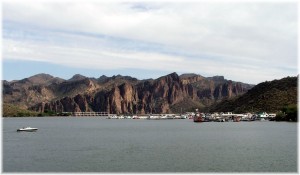
Over 100 years ago in 1903, the articles of incorporation were filed in Maricopa county by the Salt River Valley Water Users Association, (SRVWUA). In 1904, the federal government and SRVWUA signed an agreement to build Roosevelt Dam, with the members of SRVWUA pledging more than 200,000 acres of their land as collateral for the federal construction loan. Construction of the dam was completed in 1911 at a cost of $3.8 million.
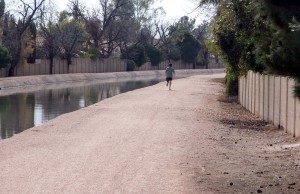 As you drive through
As you drive through 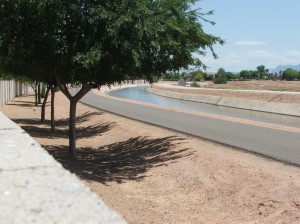 the east valley, you’ll notice the SRP canals which are used to transport water to industrial, municipal and agricultural irrigation customers throughout the SRP service area. The 131 miles of SRP canal have become a favorite with those that enjoy walking and jogging.
the east valley, you’ll notice the SRP canals which are used to transport water to industrial, municipal and agricultural irrigation customers throughout the SRP service area. The 131 miles of SRP canal have become a favorite with those that enjoy walking and jogging.
SRP currently delivers more than 1 million acre feet of water to the water service area. SRP water is treated in city water treatment plants before being delivered to customers.
Colorado River Water via the Central Arizona Project (CAP)
In 1922, the signing of the Colorado River Compact divided 7 seven states into the Upper Basin (Utah, New Mexico, Wyoming and Colorado) and Lower Basin (Arizona, Nevada and California) with the intent to divide the Colorado river equally between the Upper Basin and Lower Basin states. Within 5 months of the signing, all states ratified the agreement except Arizona! It was not until 1944 that Arizona ratified the compact, 22 years later mainly because of allocation issues with California. Arizona continued to dispute allocations until the Supreme Court finalized the allocations in the 1964 decision, Arizona vs. California. Arizona’s current allocation is 2.8 million acre feet / year. The Colorado river drains 244,000 square miles across the seven states that comprise the Upper and Lower Basin states. Because of the dependency of these seven states and Mexico on the Colorado river, historian Norris Hundley, Jr. stated that the Colorado river has been the most litigated, regulated, politicized, and argued-about river in the world.
In light of this history, it is amazing that Senator John McCain, GOP presidential candidate suggested in Aug. 2008, that the 1922 Colorado River Compact be renegotiated due to the population growth in the Lower Basin states. Ouch! That’s one way to lose votes in Colorado, New Mexico, Utah and Wyoming. Or was it to gain votes in Nevada, Arizona and California! Later, while in Colorado he said he would “never ever” try to take more of Colorado’s water. He found out the meaning of the expression, “Whiskey is for drinking, water is for fighting,”.
Getting Colorado River water to Phoenix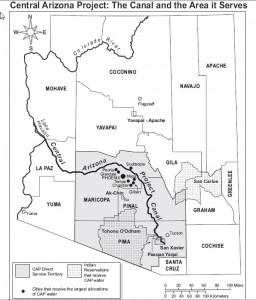
The Central Arizona Project (CAP) is a 336 mile system of aquaducts, tunnels, pumping stations, and pipelines that carry water from the Colorado River in Lake Havasu to central and southern Arizona. The project cost $4.4 billion and was conceived in the 1960’s with the purpose of helping Arizona use its allotment of water from the Colorado river. It is designed to bring 1.5 million acre feet of Colorado River water to Pima, Pinal, and Maricopa counties and is owned and operated by the United States Bureau of Reclamation.
Once it arrives, the water quality level is not of sufficient quality for human consumption. The final step is to pass through a water 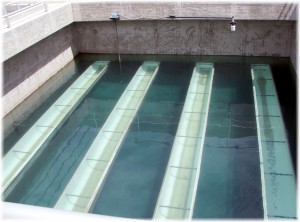 treatment plant which many confuse for a water reclamation plant used to treat sewage. The Town of Gilbert and the City of Chandler recently opened a $102 million high tech water treatment plant for water received from the Colorado River. The plant uses “ballasted flocculation” to treat Central Arizona Project water. At the current capacity, the plant can produce up to 24 million gallons of water per day. Each city has the right to half the capacity.
treatment plant which many confuse for a water reclamation plant used to treat sewage. The Town of Gilbert and the City of Chandler recently opened a $102 million high tech water treatment plant for water received from the Colorado River. The plant uses “ballasted flocculation” to treat Central Arizona Project water. At the current capacity, the plant can produce up to 24 million gallons of water per day. Each city has the right to half the capacity.
Ground Water
For many years ground water has been pumped from the ground faster than it has been replaced, creating a condition called “overdraft”. As groundwater levels fall, it is more expensive to pump and the water quality diminishes. This is an on-going issue for the valley because many areas rely on groundwater as their primary water supply.
To address this issue, the Arizona Groundwater Management Code was passed in 1980. Part of the code was the establishment of 5 Active Management Area’s (AMA’s) where the overdraft was the most severe. For the Phoenix, Prescott and Tucson AMA’s the primary goal is safe yield by the year 2025. Safe yield is defined as the long term balance of ground water withdrawn and natural and artificial recharge of the aquifer.
Reclaimed Water
Reclaimed water is a valuable resource and has a variety of uses, with the most important trait being it reduces the dependence on other sources of wate; namely ground water and surface water. Reclaimed water is primarily used for industrial purposes, irrigation of golf courses, parks, highway medians, common areas in communities, and providing decorative lakes which act as above ground storage facilities, and ground water recharge. Gilbert along with other cities in the Phoenix area are committed to using 100% of their reclaimed water.
Ground water recharge using reclaimed water
Most people would not even know that the Riparian Preserve at Water  Ranch is home to 7 recharge ponds. Reclaimed water is piped to the recharge ponds where it enters the underground aquifer and in the process goes through the natural filtering process, and helps replace groundwater that has been withdrawn. The Central Arizona Project also manages recharge projects with the goal of assisting in groundwater recharge. Chandler’s Veterans Oasis Park is similar to the Riparian Preserve in that it serves as a recreational andenvironmental education facility and a recharge facility that uses reclaimed water to recharge the aquifer and create a wetland environment.
Ranch is home to 7 recharge ponds. Reclaimed water is piped to the recharge ponds where it enters the underground aquifer and in the process goes through the natural filtering process, and helps replace groundwater that has been withdrawn. The Central Arizona Project also manages recharge projects with the goal of assisting in groundwater recharge. Chandler’s Veterans Oasis Park is similar to the Riparian Preserve in that it serves as a recreational andenvironmental education facility and a recharge facility that uses reclaimed water to recharge the aquifer and create a wetland environment.
Believe it or not, I’ve only touched the surface of water management in Arizona. The more you learn about it the more you realize there is so much more to learn. The water we enjoy in Arizona now is the result of preparation and work that began over 100 years ago with tireless work by many. That diligence continues today by stewards of Arizona’s most precious resource so that it is as easy as turning on the tap. Our responsibility is to use it wisely, enjoy it and conserve it so that we can continue to enjoy this oasis in the desert.

